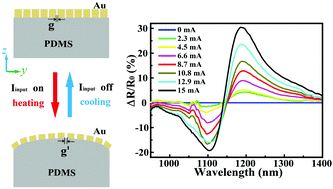Flexible plasmonic modulators induced by the thermomechanical effect†
Abstract
Reconfigurable plasmon-based flexible devices, composed of artificial plasmonic nanostructures on stretchable substrates, show great promise for dynamic functionalities such as tunability, switching and modulation of electromagnetic waves. Here, we theoretically proposed and experimentally demonstrated a simple and efficient flexible plasmonic modulator based on an array of gold nanostructures on a poly(dimethylsiloxane) (PDMS) substrate. Arising from the current-induced local Joule heat, the local expansion of the PDMS substrate widens the gap distances between the neighboring gold wires, which results in a spectral shift of the plasmon resonance. The experimental results show that the plasmon resonance has a blue-shift of 39 nm under a total power consumption of only 10.5 mW, which results in a high modulation depth of up to 30.5% for the modulator. Such a low power consumption can be ascribed to the small active area and excellent thermal isolation of the PDMS. The optical and thermomechanical responses were confirmed and understood by the electromagnetic and thermomechanical co-simulations based on the finite-difference time-domain and finite-element methods. This novel mechanism to manipulate light provides new opportunities for active optical components and integrated circuits.



 Please wait while we load your content...
Please wait while we load your content...